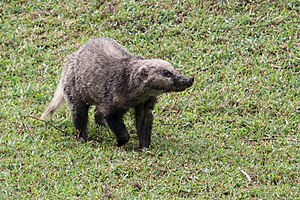Pig badger
| Pig badger | ||||||||||||
|---|---|---|---|---|---|---|---|---|---|---|---|---|

Pig badger ( Arctonyx collaris ) |
||||||||||||
| Systematics | ||||||||||||
|
||||||||||||
| Scientific name | ||||||||||||
| Arctonyx collaris | ||||||||||||
| F. Cuvier , 1825 |
The pig badger or giant badger ( Arctonyx collaris ) is a species of predator from the subfamily of badgers (Melinae) within the family of marten (Mustelidae) that occurs in Southeast Asia from northeast India through Myanmar, Thailand, Cambodia and Laos to Vietnam.
features
The pig badger reaches a head-trunk length of 65 to 104 centimeters and has a tail 19 to 29 centimeters long. This makes it the largest type of badger and almost looks like a little bear. The tail is usually a third of the length of the head and torso. The rear foot length is 11 to 13.5 inches and the ears are about 4 inches long. The skull is 15 to 17.2 cm long ( condylobasal length ) and 7.6 to 9.9 cm wide ( zygomatic arch width ). The crest of the adult animal is well developed. The front quarter of the body is in most cases blackish, the rest more or less gray in color. The pig badger can be distinguished from other pig badger species by its size, its larger and stronger molars, its lighter and shorter fur and its longer and stronger claws.
Way of life
The pig badger mostly lives in forests. The social behavior and reproductive biology of animals is not yet well known. They are probably mainly crepuscular solitary animals who sleep during the day in earthworks they have dug themselves or in crevices. The diet of the pig badger has not been thoroughly researched either. According to various, often older, information, it feeds on worms, millipedes, insects and other small invertebrates, small reptiles, including snakes, fish and carrion. Specimens kept in human care also ate bread and rice. The animals are likely to be adaptable omnivores, using a variety of food sources depending on the season, local conditions and individual preferences. The pig badger's predators are mainly larger cat species.
Systematics
The pig badger was first scientifically described in 1825 by the French zoologist Frédéric Cuvier . Cuvier also introduced the genus Arctonyx , which was monotypical for a long time with Arctonyx collaris as the only species. Arctonyx dictator and Arctonyx annaeus are synonym descriptions of Arctonyx collaris . In 2008, the American zoologist Kristofer Helgen , his wife and a colleague from Singapore published a revision of the genus Arctonyx and revalidated two other pig badger species after they were able to demonstrate significant morphological differences between the three pig badger species.
supporting documents
- ↑ a b c Kristofer M. Helgen, Norman T-Lon Lim, Lauren E. Helgen: The hog-badger is not an edentate: systematics and evolution of the genus Arctonyx (Mammalia: Mustelidae). Zoological Journal of the Linnean Society, Volume 154, Issue 2, October 2008, Pages 353-385, doi: 10.1111 / j.1096-3642.2008.00416.x
- ^ Thomas O. 1910. Two new mammals from the Malay Peninsula. Annals and Magazine of Natural History (series 8) 5: 424-426.
- ↑ Thomas O. 1921. The Arctonyx of Annam. Annals and Magazine of Natural History (series 9) 7: 524.
Web links
- Arctonyx collaris inthe IUCN 2013 Red List of Threatened Species . Posted by: Timmins, RJ, Long, B., Duckworth, JW, Wang Ying-Xiang & Than Zaw, 2008. Retrieved October 4, 2013.